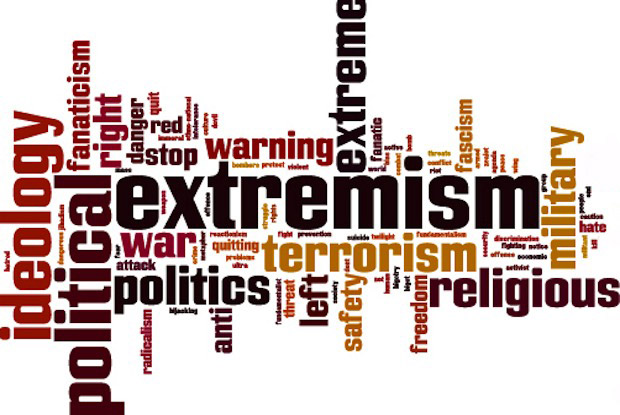Extremism has always existed although it is since the 9/11 attacks that many people around the world began to fear it. As extremism is a complex phenomenon, scholars and policy makers have significant differences as to what extremism is and is not. Desmond Tutu defined extremism this way: “when you do not allow for a different point of view; when you hold your own views as being quite exclusive, when you don’t allow for the possibility of difference” [1].
Another useful way to think about extremism is “as activities (beliefs, attitudes, feelings, actions, strategies) of a person or group far removed from the ordinary” [2]. It is clear though that the terms ‘ordinary’ and ‘extremist’ are highly subjective and are thus often and easily politicized. Extremism is the farthest out because there is nothing beyond the extreme.
Extremism is something very relative: for some it is the status quo that is the problem, while for others it is the change that some groups are calling for that labels them as radical. And when it comes to violent extremism, a group might be perceived as freedom fighters, but for others they are considered terrorists. However, these tendencies are constructed, either by political leaders who depend on extremist views to gain and hold onto power, or other dominant groups that label marginalized groups such as feminist or environmentalist as extremists in an attempt to defend their privilege. This stark contrast can be explained in terms of the different value systems held by the observers.
Very often, it is the historical and current political context that determines political perceptions; a good case in point is the Arab-Israeli conflict. Another key factor is power, which plays a critical role for the observer when talking about an extremist group, whether that group is a state or a non-state actor. Extremists are regularly associated with violence, whereby it is the term radicalization that is often used to express the process of challenging the status quo with violence [3]. This can lead to fundamentalism in order to reclaim some perceived loss from earlier times [4].
Contrary to widespread perception, extremism is not necessarily violent. In fact, extremists might call for non-violent means to overcome cultural and structural violence (like sexism or girls not being allowed to go to school), concepts developed by the peace researcher Johan Galtung [5]. Overcoming social injustice, or a status quo of inequality, is interpreted as something positive by many social movements. It is the use of violence that stands out as the most controversial part about how to bring about change. Many civil society groups who want to help creatively and constructively transform their societies reject its use.
The phenomenon of extremism can be explained by social identity theory that analyzes from a psychological perspective why group identification pushes members into an “in-group” while devaluing the “out-group,” ultimately leading to polarization [6]. This can and often does lead to extremist views about the other and the acceptance of that labeling by certain groups. In the latter case, extremists use public actions to draw attention to their cause (like some animal rights activists) so that others might become sensitized to this cause and attracted enough to join the movement.
On the downside, extremists often use physical violence that causes harm, death and destruction. Moreover, their violent strategy usually alienates potential allies because it goes against their values and worldview. But from the extremists’ point of view, these actions and strategies are righteous and essential because they are finally taking action to respond to previous experiences of humiliation or loss. It is therefore important to point out that extremism is rational [2] and its resultant acts understood as justifiable.
For many people extremism has a pejorative connotation that expresses clear disapproval of the ‘extremist’ thoughts and actions. In the post-9/11 world, extremism is often negatively linked to Islam, as well as with terrorism. However, this short paper will try to expand this limited view of extremism and include other dimensions as well, particularly political and social extremism. Finally, deradicalization is discussed to present some of today’s strategies that try to overcome violent extremist attitudes—that seem to be so resistant to change.
Political extremism
Over the years, multiple forms of political extremism have evolved, including totalitarian regimes (like Nazism, fascism or Soviet-style communism), rampaging military (like Japan or Indonesia), or extreme ethno-nationalism (like in Serbia, Croatia, or Rwanda). Particularly after the Russian Revolution of 1917, the phrase extremism in the political space was coined, as other European governments feared that the Communists would overthrow their regime as well. Political extremism is not necessarily promoting physical violence, although it usually includes cultural and structural violence against “the other” (usually a minority, whether religious, ethnic, political, or racial).
Much of the academic literature has focused on right-wing extremism in Western Europe due to the experience of fascism in the inter-war period but also because it has been perceived as an anti-democratic force that undermines Western values [7] [8](Knigge, 1998). These views are often based on the research of Adorno in the 1950s related to the concept of an authoritarian person who ultimately rejects pluralism and egalitarianism and speaks out for aggressive nationalism and against minorities.
Extreme right-wing parties themselves are characterized by their anti-system ideology and their narratives that are directed against the current political culture, mixed (most of the time) with ethno-nationalist perspectives and racist attitudes. Thus, the issue of immigration is usually high on the agenda for right-wing extremists, arguing for discrimination against foreigners.
Extreme right-wing parties usually use strategies that shift the narratives in their country towards their position. They try to shift public opinion in a manner that makes formerly unacceptable positions in politics “normal” in their context. It is often men, small-business owners, the very young as well as the old and socio-economically volatile people that vote for these parties. Despite recent success of right-wing extremists in Europe, it is important to remember that their electoral success is usually not strong over the long term [9].
The consumption of media plays a large role in potentially fostering political extremism [10]. Although the internet and social media have enormously democratized our access to media, they have at the same time become very polarizing, as seen in the current election cycle in the United States. As long as individuals limit their online presence to their own group, there is a likelihood of them becoming increasingly radicalized through a process of singular thinking and narrow opinion development, potentially leading to hatred and even violence [11]. Thus, the internet has fragmented societies and we can see an ever more aggressive interaction in play in this medium. It seems the internet doesn’t allow much space for disagreement, but rather has become a place to trump the other.
Extremist views are relatively uninformed about policy suggestions from different political groups, although some people have very strong opinions about certain topics like climate change, health care or poverty. It is often “unjustified confidence” of people who have relatively little knowledge but when asked to provide more substantial arguments, have a difficult time to do so. By simply having them discuss in more breadth and detail their extreme views on political issues, the participants of a psychological study had their assumptions challenged and ultimately moderated their positions on political topics [12].








































admin in: How the Muslim Brotherhood betrayed Saudi Arabia?
Great article with insight ...
https://www.viagrapascherfr.com/achat-sildenafil-pfizer-tarif/ in: Cross-region cooperation between anti-terrorism agencies needed
Hello there, just became aware of your blog through Google, and found ...